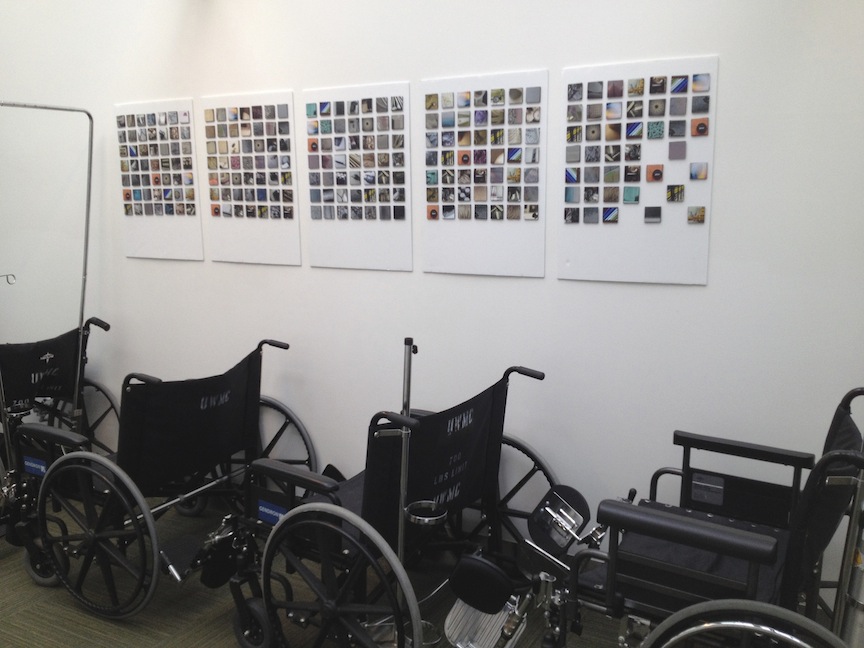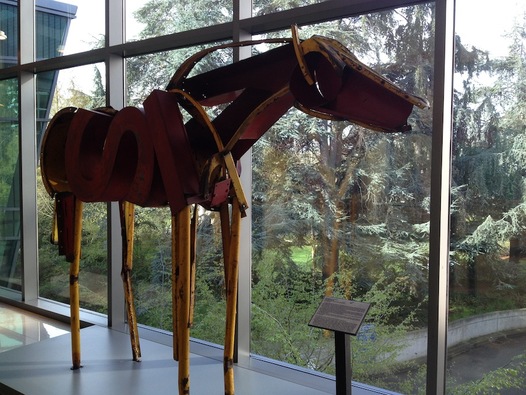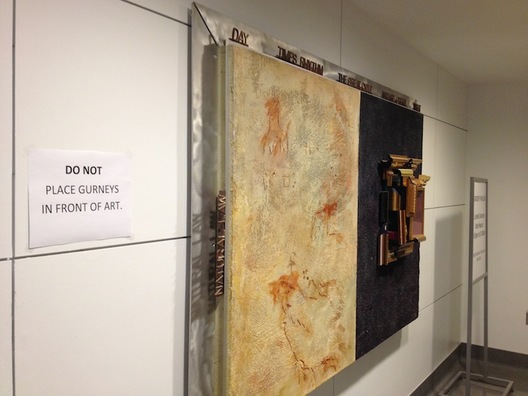|
Voices in the Hospital Gallery: Musings on Art “Art’s whatever you choose to frame.”—Fleur Adcock, “Leaving the Tate” In the spacious, well-lit corridor of a major metropolitan hospital, a line of empty wheelchairs like taxis at an airport, a train of black and silver, press lightly against a white wall. Grids of 2-inch square photos, in 7 x 7 rows, hang above, part of an art project collaboration between medical students and photo-media students. Unintentional juxtaposition. Images in the grid: stethoscope and lens cap, otoscope head and “help” buzzer button, fragments, the top of a sanitizing liquid dispenser and color-coded chart tabs. Birds eye view of Q-tips and tongue depressors, an MRI stretcher-bed and vials of saline in marked tubes. Four of these prismatic grids with repeating and distinct images, sequences of chromatic variations like slides of stained cells. And yet. Some things defy measurement, defy scientific knowledge, fall away from our grasp and so there are missing squares on the fourth grid, empty spaces above the empty wheelchairs. The wheelchairs wait. Not meant as “art” they have become so, they have merged with the images above. This armada for arms, bodies and feet also speaks to what is missing from the photos above. There aren’t any human body parts visible. The next time I come to visit, the wheelchairs are gone. Deployed elsewhere? My view of the exhibit changes. Easier to see the images on the wall, easier to detach from the fact of a hospital. My perception is more simplified and reduced simultaneously, as if I’ve been transported out of the environment. Even though the images speak to medicine, the wheelchairs added an immediacy the grids lack. How do poets respond to other artist’s work? Where do I put my frame? I always want to be mindful of the context in which I’m viewing. In this same Sky Gallery, four plexi-glass boxes of eyes, about 30 in each, made by people working, visiting or staying in the hospital. No two alike though each began with the same blank, almond-shaped template. Riveted by eyes, rivets on eyes, a river of eyes. What you see, what they reflect, is from the outside looking in, or inside looking out. Some are literal eyes, with lashes, pupils and irises. The blue-eyed congregate with like-eyed as do the black and brown ones. Some are figurative, imagistic, symbolic. A heart where the pupil is and inside the heart, a book. One eye is decorated with paper leaves for lashes, constellations in the night sky fill what is usually white space, the pupil is a flower. “I always see / the forest” says the I-eye. In another part of the hospital a sign reads: DO NOT PLACE GURNEYS IN FRONT OF ART. A large, multi-media piece by Dennis Evans hangs next to it. Metal words frame the outside of the 5 x 10 foot piece. Natural Law hangs next to the warning sign. And the laws of nature say that nature abhors a vacuum so gurney attendants looking for a place to stash them must have found the space convenient. Was there a patient on the gurney who needed to rest, to gaze at something other than the white ceiling? Continuing over the top of the frame, Day, Times Rhythm, The Great Cycle, Nature Opera and Night carry on. Bifurcated canvas of creamy yellow and black further delineate day and night. Though no gurneys currently block the art, clearly one or more have. The second part of this art piece hangs directly opposite it, across the hall, and bears the ravages of being “equipment damaged.” It is missing three of its 5 metal ‘rocks’ which were once outcroppings on the piece that speaks to the balance of nature and science. Now out of balance, it appears as an amputee. This hospital, one of three in the area with significant collections of: paintings, sculptures, mixed media, crafts: woven, carved, glazed, sewn, stuffed, installed, photographed, made by “professional” artists, patients, doctors, nurses, and staff, is a testament to the need for, and high regard for, voices from both sides of the body/mind. “Is this a museum or a hospital?” a child asks his father. We are standing in an atrium space between surgery clinics. It is airy and spacious. A spiral staircase cascades down four flights from skylight to blue-rock pool. Touching art is often prohibited here, as in a museum, but in this space, a life-sized horse by Deborah Butterfield, made from recycled, metal scrap, can be petted. He gazes forever out the wall of glass to grass he’ll never graze. We hunger for escape too, hope that what ails us and what heals us can balance, lets us walk out unaided by chair or gurney, lets us reframe our world. As Fleur Adcock said: …Put what space you like around the ones you fix on, and gloat. Art multiplies itself. Art’s whatever your choose to frame. Suzanne E. Edison Suzanne's work appears, among other places, in: her chapbook, The Moth Eaten World, Finishing Line Press, 2014; Spillway; Crab Creek Review; The Healing Art of Writing, Vol. 1; The Examined Life Journal; Face to Face: Women Writers on Faith, Mysticism and Awakening, and www.literarymama.com. www.seedison.com All photographs by the author. All artwork resides in the University of Washington Medical Center Hospital, Seattle, Washington.
1 Comment
7/21/2016 01:40:41 pm
This is beautifully written, a piece of art itself. Thank you!
Reply
Your comment will be posted after it is approved.
Leave a Reply. |
The Ekphrastic Review
COOKIES/PRIVACY
This site uses cookies to deliver your best navigation experience this time and next. Continuing here means you consent to cookies. Thank you. Join us on Facebook:
July 2024
|






